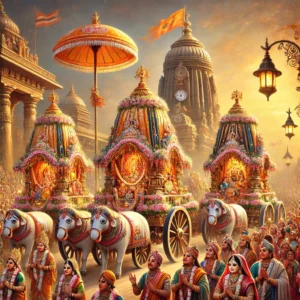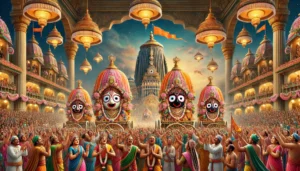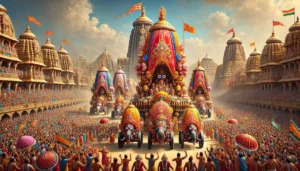
Why is Niladri Bije the final ritual
The ‘Niladri Bije’ Ceremony: Lord’s Homecoming
The Jagannath Temple in Puri, Odisha, is home to one of the most revered deities in Hinduism—Lord Jagannath, along with His siblings, Lord Balabhadra and Devi Subhadra. Among the grandest festivals celebrated here, the Rath Yatra holds a special place, culminating in the emotionally profound and culturally rich Niladri Bije ceremony. This ritual marks the return of the divine trio to the sanctum sanctorum of the Srimandir after their annual journey to the Gundicha Temple.
The Journey of Rath Yatra
The Rath Yatra, also known as the Festival of Chariots, commences on the second day of the bright fortnight in the month of Ashadha (June-July). Lord Jagannath, Lord Balabhadra, and Devi Subhadra embark on their chariot journey from the Jagannath Temple to the Gundicha Temple, their aunt’s home, where they stay for nine days. This annual journey symbolizes the Lord’s desire to meet His devotees outside the temple premises. Devotees throng the streets of Puri, pulling the massive chariots and chanting hymns in devotion.
The Return Journey: Bahuda Yatra and Suna Besha
After their stay at the Gundicha Temple, the divine siblings commence their return journey, known as Bahuda Yatra. This journey takes place on the ninth day, retracing their path back to the Srimandir. During this time, a significant event called Suna Besha is observed, where the deities are adorned with gold ornaments, presenting a majestic spectacle to the devotees. Before re-entering the temple, the deities make a stop at the Mausima Temple, where they are offered poda pitha, a traditional sweet dish. Devotees believe that this marks the Lord’s affection for His people and His desire to partake in their simple offerings.
The ‘Niladri Bije’ Ceremony
The Niladri Bije ceremony, observed on the concluding day of the Rath Yatra festival, marks the final return of the deities to their original abode inside the temple. However, this homecoming is not without a dramatic and significant ritual that adds to the deep cultural essence of the event.
Table of Contents

Why is Niladri Bije the final ritual of Rath Yatra?
The Divine Play: Lakshmi and Jagannath’s Reconciliation
A key highlight of Niladri Bije is the enactment of an emotional episode between Lord Jagannath and Goddess Lakshmi. According to temple traditions, when Lord Jagannath leaves for the Gundicha Temple, He does so without informing Goddess Lakshmi, His consort. This act of apparent neglect angers the Goddess, who remains in Srimandir, awaiting His return.
When the Lord arrives at the temple gates, Goddess Lakshmi refuses to allow Him entry, expressing her displeasure at being left behind. What follows is an affectionate yet dramatic interaction where Lord Jagannath must appease Goddess Lakshmi by offering her sweets and gifts. Only after His persuasive efforts does she allow Him to enter the sanctum sanctorum. This beautiful ritual symbolizes the eternal bond between the divine couple and emphasizes the importance of love, patience, and reconciliation. The ceremony also depicts how even divine beings engage in playful quarrels, making them relatable to human emotions.
Rasgulla Bhoga: A Sweet Offering
An integral part of Niladri Bije is the offering of Rasgulla to Goddess Lakshmi. This is a token of Lord Jagannath’s affection and an attempt to pacify Her anger. This tradition is believed to have inspired the famous Rasgulla Dibasa (Rasgulla Day) in Odisha, celebrating the rich cultural heritage of this iconic sweet. The ritual reinforces the notion that even divine disputes can be resolved with love and sweet offerings, a message that resonates deeply with devotees.
Spiritual and Cultural Significance
The Niladri Bije ceremony is not just a religious observance but a cultural spectacle that reinforces the deep emotional connection devotees share with Lord Jagannath. It signifies the culmination of the grand Rath Yatra and reinstates the belief that Lord Jagannath, as a divine entity, embodies both human emotions and celestial grace.
Devotees eagerly await this sacred event, offering prayers, singing devotional hymns, and rejoicing in the Lord’s return to His holy abode. The Niladri Bije is a testament to the enduring faith, devotion, and cultural richness associated with the Jagannath tradition, making it an unparalleled spiritual experience for millions.
Moreover, the festival brings together people from different walks of life, transcending caste, creed, and societal boundaries. The inclusiveness of Lord Jagannath’s worship reflects the deity’s universal acceptance and love for humanity.
Conclusion
The Niladri Bije ceremony beautifully encapsulates the divine drama of separation and reunion, devotion and reconciliation, making it one of the most cherished rituals in the Jagannath cult. It is a celebration of faith, devotion, and divine love, bringing together thousands of devotees to witness the grand return of their beloved Lord Jagannath to His eternal home. The festival not only reinforces spiritual values but also strengthens cultural bonds, making it a deeply ingrained tradition that continues to inspire generations.

Why is Niladri Bije the final ritual of Rath Yatra?
FAQs on Niladri Bije: The Divine Homecoming of Lord Jagannath
- What is Niladri Bije?
Niladri Bije is the final ritual of the world-famous Rath Yatra of Lord Jagannath, Balabhadra, and Devi Subhadra in Puri, Odisha. It marks their return to the sanctum sanctorum of the Jagannath Temple after spending nine days at the Gundicha Temple, their “Mausi Maa” (Aunt’s home). This sacred event is steeped in tradition, devotion, and cultural significance.
- When is Niladri Bije observed?
Niladri Bije takes place on the twelfth day of the bright fortnight (Shukla Paksha) of the Ashadha month (June–July), four days after the Bahuda Yatra (Return Journey).
- What is the sequence of Niladri Bije?
On Niladri Bije, the deities re-enter the temple in the following order:
- Lord Balabhadra enters first.
- Devi Subhadra follows.
- Lord Jagannath is the last to enter.
- Lord Sudarshan (the divine wheel) enters after Lord Jagannath.
This sequence is significant and is strictly followed every year.
- Why is Niladri Bije significant?
Niladri Bije is not just the conclusion of Rath Yatra but also symbolizes:
- The return of the divine siblings to their permanent abode, the Ratna Singhasana (bejeweled throne).
- The divine union of Lord Jagannath and Goddess Lakshmi, after their temporary separation.
- The reaffirmation of faith, as thousands of devotees witness this sacred event, offering prayers for well-being and prosperity.
5. What is the famous ‘Lakshmi-Narayana’ episode during Niladri Bije?
As per tradition, when Lord Jagannath returns to the temple, Goddess Lakshmi, His consort, is upset because He left without informing Her. She orders Her attendants to close the temple doors, preventing Lord Jagannath from entering. This divine play signifies the divine leela (pastime) between a husband and wife.
To pacify Her, Lord Jagannath offers Rasagola (a soft, syrupy sweet), symbolizing love and reconciliation. Only after this offering does Goddess Lakshmi allow Him to re-enter the sanctum.
This ritual is deeply connected to Odisha’s Rasagola Dibasa (Rasagola Day), celebrated to honor the state’s rich cultural heritage.
- Why is Rasagola offered to Goddess Lakshmi?
Rasagola is offered as a gesture of love, respect, and devotion. It is believed that this offering soothes Her anger and re-establishes harmony. This act is an integral part of Odia culture and has led to Odisha celebrating Rasagola Dibasa on this day.
- What role does Goddess Lakshmi’s procession play?
A day before Niladri Bije, the Hera Panchami ritual takes place, where Goddess Lakshmi secretly visits the Gundicha Temple to express Her displeasure. She later returns to the main temple. This entire sequence represents the divine interaction between the Lord and His beloved consort.
- What is unique about Niladri Bije compared to other Rath Yatra rituals?
Unlike the grand chariot processions and public celebrations, Niladri Bije is a more intimate and symbolic event. The most notable aspects include:
- The controlled entry of the deities in a strict sequence.
- The symbolic reunion of Lord Jagannath and Goddess Lakshmi.
- The offering of Rasagola, a unique tradition found only in Odisha.
9. Can devotees witness the Niladri Bije ceremony?
Yes, devotees can watch the Rasagola offering and the deities’ return to the temple. However, once the deities enter the sanctum, the doors are closed for certain secret rituals performed only by the temple priests.
- What happens after Niladri Bije?
After Niladri Bije:
- The deities resume their daily temple rituals, including darshan and offerings.
- The Ratna Singhasana (Bejeweled Throne) welcomes them back, signifying their permanent stay in the temple.
- The temple regains its usual daily rhythm until the next Rath Yatra cycle begins the following year.
9. How does Niladri Bije influence Odia culture and traditions?
Niladri Bije is deeply embedded in Odia heritage and spiritual consciousness. It reinforces:
- The importance of Rasagola as a cultural symbol (leading to the state’s Geographical Indication (GI) tag for Odisha Rasagola).
- The significance of devotion, love, and reunion through divine interactions.
- The grandeur of Puri’s Jagannath tradition, inspiring devotees worldwide.
10. Is Niladri Bije celebrated outside Odisha?
While Niladri Bije is uniquely associated with Puri’s Jagannath Temple, several Jagannath temples across India and abroad recreate its essence. Devotees in Odisha and Odia communities worldwide observe the day by offering Rasagola to Lord Jagannath as a mark of devotion.
Conclusion
Niladri Bije is not just the conclusion of Rath Yatra; it is a spiritual homecoming filled with divine love, tradition, and Odia cultural pride. From the grand chariot journey to the sweet reconciliation with Goddess Lakshmi, this sacred event is a reminder of the eternal connection between the Lord and His devotees.
Summary
Niladri Bije: The Divine Homecoming of Lord Jagannath
Niladri Bije is the final and most significant ritual of the annual Rath Yatra festival in Puri, Odisha, marking the divine return of Lord Jagannath, along with His siblings Balabhadra and Subhadra, to the sanctum of the Srimandir (Jagannath Temple). Taking place on the twelfth day of the Rath Yatra, this sacred event concludes the Lords’ grand chariot journey, which begins with their departure from the Srimandir to the Gundicha Temple, their sojourn at their birthplace, and their visit to the Mausi Maa Temple.
The Ritual and Its Significance
As the deities prepare to enter the Srimandir, an intriguing and symbolic ritual unfolds at the temple gates. Goddess Lakshmi, the divine consort of Lord Jagannath, expresses her displeasure at being left behind during the journey and initially refuses to allow Him re-entry into His abode. This dramatic yet spiritually profound episode represents the divine interplay between love, separation, and reunion.
To appease the Goddess, Lord Jagannath offers her gifts, including Rasagola (a traditional sweet delicacy of Odisha). This gesture symbolizes His acknowledgment of her emotions and serves as a reconciliation, after which the doors are opened, allowing Him and His siblings to re-enter their divine dwelling. This act not only portrays the essence of love and devotion but also highlights the cultural significance of offering sweets as a token of affection and peace.
The Cultural and Spiritual Essence
Niladri Bije is not just a religious ceremony but a deeply symbolic event that reflects the philosophy of Jagannath culture, where the divine is approached with emotions and relationships akin to human experiences. The festival showcases themes of devotion, longing, forgiveness, and divine reunion, which resonate with devotees on a spiritual level.
Moreover, the tradition of offering Rasagola to Goddess Lakshmi has led to the celebration of “Rasagola Dibasa” in Odisha, commemorating the deep-rooted cultural heritage associated with this ritual.
Conclusion
With the completion of Niladri Bije, the Lord’s divine journey comes full circle, signifying the cosmic cycle of departure and return, separation and reunion. This festival reaffirms the bond between the divine and the devotees, reminding them of the eternal nature of love, devotion, and reconciliation. The grandeur, the deep-rooted traditions, and the emotional depth of Niladri Bije make it one of the most cherished rituals in Jagannath culture, leaving an everlasting spiritual impact on those who witness it.
Unlock the Ancient Wisdom of Sanatan Dharma – Join Us on YouTube!
👉 Subscribe now to Prachin Sanatan Dharma and embark on a journey of enlightenment.
Explore timeless teachings, spiritual insights, and cultural richness on our YouTube channel, Prachin Sanatan Dharma. Dive deep into the essence of Sanatan Dharma through captivating videos that inspire and educate.
Related Articles
- Restful Nights: Ayurvedic Remedies and Traditional Indian Practices to Overcome Insomnia and Late-Night Habits
- The Tridevi: Lakshmi, Saraswati, and Parvati – Their Roles and Powers
- “Divine Creatures of Ancient Indian Scriptures: Exploring the Role of Animals in the Vedas, Puranas, and Mahabharata”
- Nature and Spirituality: Exploring the Sacred Essence of the Himalayas, Ganga, and Other Natural Wonders”
- “Reviving the Gurukul System: Relevance and Lessons for Modern Education”
- “Exploring Greek and Indian Mythology: Similarities Between Greek and Indian Mythology “
- “Embracing Sattvic Living: Harmonizing Mind, Body, and Soul Through Food and Lifestyle”
- “Charity and Prosperity: Exploring the Concept of Daan and Its Financial Relevance in Modern Life”
- How to Build an Eco-Friendly Home Inspired by Vastu Shastra
- Comparison of Ancient and Modern Sports: How Traditional Sports Have Influenced Contemporary Games
- “Timeless Lessons from Ancient Tales: Linking Samudra Manthan and Ganga’s Descent to Modern Ecological Challenges”
- “Reviving Sanskrit: How AI is Preserving Ancient Languages for the Future”
- “Mathura: The Sacred Land of Lord Krishna’s Divine Leelas”
- Investing for Future Generations: Lessons from Indian Traditions on Legacy Building and Wealth Preservation
- “Ancient Indian Wisdom: Timeless Lessons for Tackling Today’s Climate Crisis”
- “Artificial Intelligence and Spirituality: Transforming Ancient Practices for the Modern World”
- “Gold and Real Estate in India: Timeless Assets Shaping Financial Strategies”
- Tradition Meets Innovation: The Evolution of Technology in Hindu Rituals
- End-of-World Myths: Exploring Kali Yuga in Hinduism and Ragnarök in Norse Mythology
- Garuda, Pegasus, and Dragons: The Universal Ties of Mythical Beasts Across Cultures
- “Ancient Vimanas: Mythical Flying Machines or Evidence of Advanced Technology?”
- Time Travel in Hindu Mythology: The Fascinating Tales of Kakudmi and King Raivata
- “Divine Feminine Power in Hindu Mythology: The Legends of Durga, Saraswati, and Lakshmi”
- “Divine Beings of Sanatan Dharma: The Spiritual Significance of Sacred Animals in Hinduism”
- “Symbolism in Mythological Art: Unlocking Hidden Meanings in Ancient Temple Carvings”
- “Exploring Technological Advancements in Ancient India and Civilizations: Vimana, Metallurgy, & Water Management systems”
- Unveiling the Mysteries: Ancient Temples of Sanatan Dharma , Mysterious Temples of India
- “The Scientific Knowledge of Sanatan Dharma: Ancient Wisdom Meets Modern Science”
- Ancient Indian Sports and Games: Celebrating a Legacy of Skill, Strength & Strategy”
- “Exploring the Cosmic Link: The Connection Between Astronomy and Vedic Astrology”
- The Power of Sanskrit: Unlocking the Divine Language of the Gods
- “The End of Kaliyuga: A Sanatan Insight into the World’s Final Chapter”
- Explore more articles on Prachin Sanatan Yuga.
Why is Niladri Bije the final ritual of Rath Yatra? Why is Niladri Bije the final ritual of Rath Yatra?Why is Niladri Bije the final ritual of Rath Yatra? Why is Niladri Bije the final ritual of Rath Yatra?
Why is Niladri Bije the final ritual of Rath Yatra? Why is Niladri Bije the final ritual of Rath Yatra? Why is Niladri Bije the final ritual of Rath Yatra?Why is Niladri Bije the final ritual of Rath Yatra? Why is Niladri Bije the final ritual of Rath Yatra? Why is Niladri Bije the final ritual of Rath Yatra? Why is Niladri Bije the final ritual of Rath Yatra?Why is Niladri Bije the final ritual of Rath Yatra? Why is Niladri Bije the final ritual of Rath Yatra?
Why is Niladri Bije the final ritual of Rath Yatra? Why is Niladri Bije the final ritual of Rath Yatra? Why is Niladri Bije the final ritual of Rath Yatra?Why is Niladri Bije the final ritual of Rath Yatra? Why is Niladri Bije the final ritual of Rath Yatra? Why is Niladri Bije the final ritual of Rath Yatra? Why is Niladri Bije the final ritual of Rath Yatra?Why is Niladri Bije the final ritual of Rath Yatra? Why is Niladri Bije the final ritual of Rath Yatra?
Why is Niladri Bije the final ritual of Rath Yatra? Why is Niladri Bije the final ritual of Rath Yatra? Why is Niladri Bije the final ritual of Rath Yatra?Why is Niladri Bije the final ritual of Rath Yatra? Why is Niladri Bije the final ritual of Rath Yatra? Why is Niladri Bije the final ritual of Rath Yatra? Why is Niladri Bije the final ritual of Rath Yatra?Why is Niladri Bije the final ritual of Rath Yatra? Why is Niladri Bije the final ritual of Rath Yatra?
